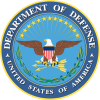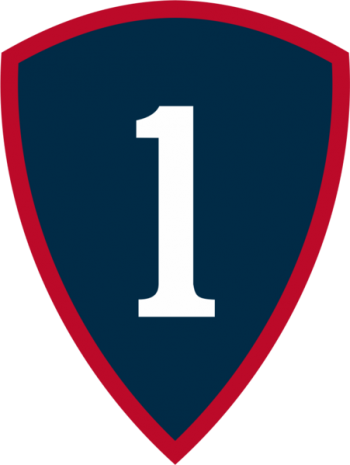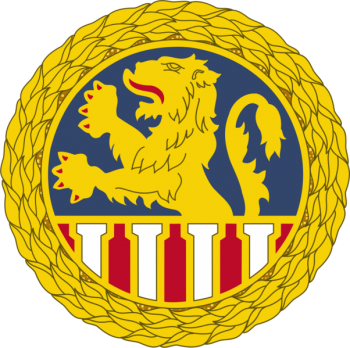1st Personnel Command, US Army: Difference between revisions
Knorrepoes (talk | contribs) m (Text replacement - "===Origin/meaning=== {{missing}} {{media}}" to "===Origin/meaning=== {{missing}} {{media}}") |
No edit summary |
||
| Line 12: | Line 12: | ||
===Official blazon=== | ===Official blazon=== | ||
Shoulder Sleeve Insignia, Description: A shield-shaped device edged with a 1/8 inch (.32cm) scarlet border, the overall dimensions 3 5/16 inches (8.41cm) high and 2 1/2 inches (6.35cm) at its widest point consisting of a dark blue shield on which is centered a white Arabic numeral one. | |||
Distinctive Unit Insignia, Description: A gold color metal and enamel device 1 3/16 inches (3.02cm) in height overall consisting of a disc divided horizontally, dark blue above and the smaller area below in red; in base four white demi-columns and at top a gold demi-lion with red claws and tongue all encircled by a gold wreath. Insignia to be worn in pairs. | |||
===Origin/meaning=== | ===Origin/meaning=== | ||
Shoulder Sleeve Insignia: Blue, white and red are the National colors. General Regulations of the Army of 1825 provided that "…dark blue is the national color." In addition, it is indicative of loyalty and firmness. White is representative of knowledge and training. Scarlet refers to courage and zeal. The three colors allude to characteristics the personnel of the Command require in the accomplishment of their mission. The Arabic numeral is indicative of the numerical designation of the Command and also represents the aspirations of the Command personnel in performance of duty. | |||
Distinctive Unit Insignia: Dark blue and scarlet are the colors traditionally associated with the Adjutant General’s Corps and denote the Command’s affiliation with the Corps that has traditionally served as the Army’s personnel and administrative system operators. The gold lion is adapted from the City of Schwetzingen’s coat of arms and refers to the unit’s first home in the European Theater. The four pillars represent the four main areas of the 1st HRC mission – personnel, administrative management, morale support and postal. The round device framed by a gold wreath signifies the totality and denotes the quality of service provided to the commanders and soldiers in the Theater Army. | |||
The Shoulder Sleeve Insignia was approved on 7 November 1978. The Distinctive Unit Insignia was originally approved on 14 Aug 1981. It was amended on 16 Aug 1983 to reflect that the insignia is manufactured in pairs. | |||
{{media}} | {{media}} | ||
[[Literature]]: Images from Wikimedia Commons | [[Literature]]: Images from Wikimedia Commons. Information from The Institute of Heraldry, US Army. | ||
[[Category:Military heraldry of the United States]] | [[Category:Military heraldry of the United States]] | ||
[[Category: Army heraldry]] | [[Category: Army heraldry]] | ||
[[Category: Granted 1978]] | |||
[[Category: Granted 1981]] | |||
Revision as of 12:22, 7 February 2021
US heraldry portal
This page is part of the US heraldry portal |
Heraldry of the World |
|
US heraldry:
|
Ecclesiastical Heraldry of the USA:
Military Heraldry: |
1ST PERSONNEL COMMAND, US ARMY
| (Shoulder Sleeve Insignia) |
(Distinctive Unit Insignia) |
Official blazon
Shoulder Sleeve Insignia, Description: A shield-shaped device edged with a 1/8 inch (.32cm) scarlet border, the overall dimensions 3 5/16 inches (8.41cm) high and 2 1/2 inches (6.35cm) at its widest point consisting of a dark blue shield on which is centered a white Arabic numeral one.
Distinctive Unit Insignia, Description: A gold color metal and enamel device 1 3/16 inches (3.02cm) in height overall consisting of a disc divided horizontally, dark blue above and the smaller area below in red; in base four white demi-columns and at top a gold demi-lion with red claws and tongue all encircled by a gold wreath. Insignia to be worn in pairs.
Origin/meaning
Shoulder Sleeve Insignia: Blue, white and red are the National colors. General Regulations of the Army of 1825 provided that "…dark blue is the national color." In addition, it is indicative of loyalty and firmness. White is representative of knowledge and training. Scarlet refers to courage and zeal. The three colors allude to characteristics the personnel of the Command require in the accomplishment of their mission. The Arabic numeral is indicative of the numerical designation of the Command and also represents the aspirations of the Command personnel in performance of duty.
Distinctive Unit Insignia: Dark blue and scarlet are the colors traditionally associated with the Adjutant General’s Corps and denote the Command’s affiliation with the Corps that has traditionally served as the Army’s personnel and administrative system operators. The gold lion is adapted from the City of Schwetzingen’s coat of arms and refers to the unit’s first home in the European Theater. The four pillars represent the four main areas of the 1st HRC mission – personnel, administrative management, morale support and postal. The round device framed by a gold wreath signifies the totality and denotes the quality of service provided to the commanders and soldiers in the Theater Army.
The Shoulder Sleeve Insignia was approved on 7 November 1978. The Distinctive Unit Insignia was originally approved on 14 Aug 1981. It was amended on 16 Aug 1983 to reflect that the insignia is manufactured in pairs.
Contact and Support
Partners:
Your logo here ?
Contact us
© since 1995, Heraldry of the World, Ralf Hartemink 
Index of the site
Literature: Images from Wikimedia Commons. Information from The Institute of Heraldry, US Army.
















